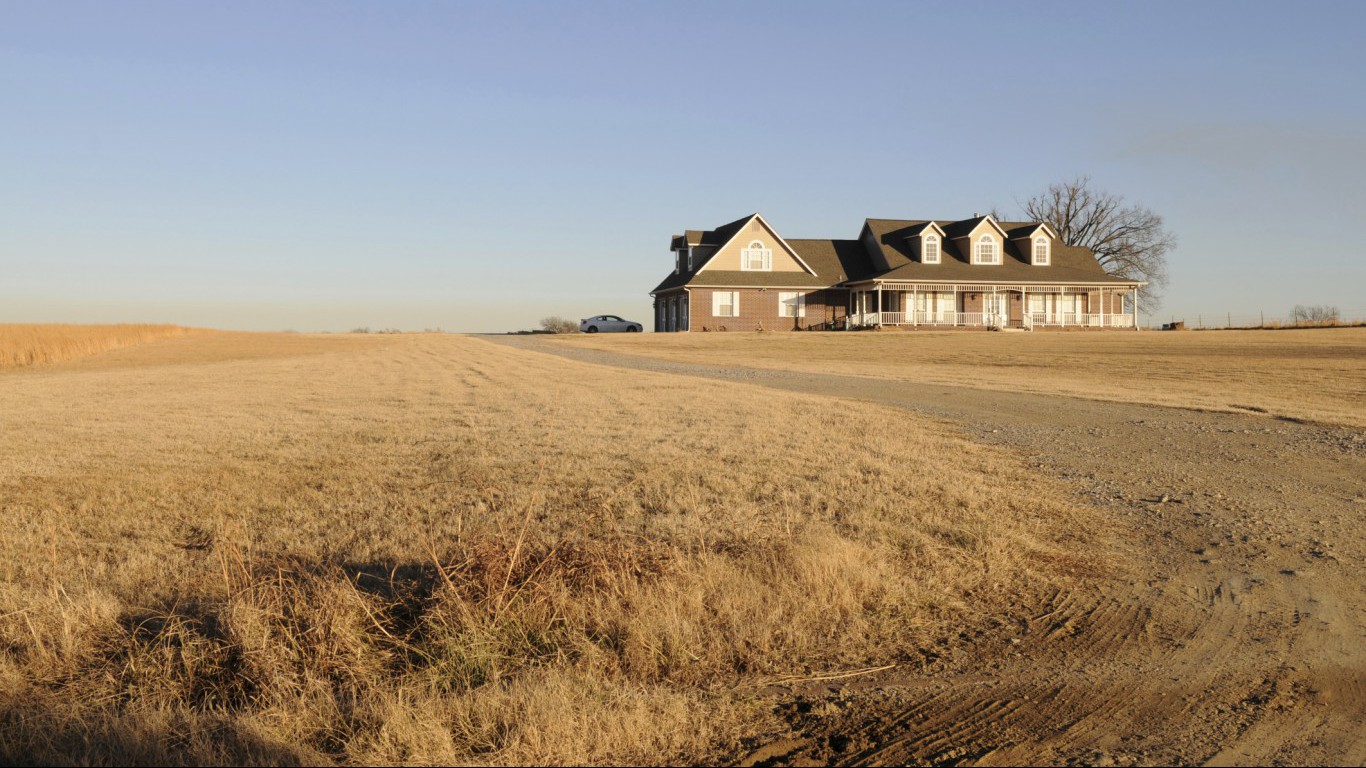Special Report
The Most (and Least) Healthy States: A Survey of All 50

Published:
Last Updated:

Progress in a society can be measured by steady improvement in health outcomes. The United States has improved in some health areas over the years, yet is facing serious challenges in others, according to the latest report from the United Health Foundation. The report’s findings also show health outcomes differ widely across states, and the likelihood of living a healthy life largely depends on where you live.
To provide a more complete picture of where the country is succeeding and where it is failing, the United Health Foundation’s 2017 America’s Health Rankings report examined both determinants and health outcomes. The UHF included for each state such measures as healthy behaviors, quality of health care, health policy, the incidence of diseases, and preventable deaths.
Due to policy and awareness, the nationwide smoking rate fell from 29.5% in 1990 to 17.1% last year, while immunization rates for children and adolescents have increased. However, obesity and drug-related fatalities have risen dramatically over that time. Approximately 30% of the U.S. adult population is obese, up considerably from 11.6% in 1990.
There has also been a 7% increase in drug deaths over the last five years, one of most troubling trends identified in the report. Drug overdose is the leading cause of injury death in the United States. There were a record high 64,068 drug overdose deaths in 2016, up from last year’s toll of 47,000. This has likely contributed to the recent rise in premature deaths nationwide. After falling steadily for decades, the premature death rate rose for the third consecutive year.
In an interview with 24/7 Wall St., Rhonda Randall, senior medical advisor to the UHF, said that a variety of complex factors can explain poor health and the resulting untimely deaths in a given state. “No one of these measures alone really tells you the health of a state,” Randall said. Likewise, states typically do well in some health measures and poorly in others. “Every state has areas that have opportunities for improvement.”
Click here to see the most (and least) healthy states.
Click here to see our detailed findings and methodology.

1. Massachusetts
> Pct. obese: 23.6% (2nd lowest)
> Cardiovascular deaths per 100,000 people: 208.3 (3rd lowest)
> Primary care physicians per 100,000 people: 237.1 (2nd highest)
> Uninsured rate: 2.7% (the lowest)
Overtaking Hawaii as the healthiest state in the country, Massachusetts has one of the lowest infant mortality rates and premature death rates of any state. Such positive outcomes are largely attributable to access to care. Only 2.7% of residents in Massachusetts lack health insurance, the lowest uninsured rate among states. Additionally, there are 81 dentists, 547 mental health providers, and 237 primary care physicians for every 100,000 state residents, each either the highest or second highest concentration of any state.
Despite ranking as the healthiest state, Massachusetts is not without its challenges. There are 20 drug deaths per 100,000 Massachusetts residents each year, well above the comparable national rate of 15 drug deaths per 100,000. Drug deaths have increased by 69% in the state in the past five years.
[in-text-ad]

2. Hawaii
> Pct. obese: 23.8% (3rd lowest)
> Cardiovascular deaths per 100,000 people: 210.7 (4th lowest)
> Primary care physicians per 100,000 people: 179.9 (9th highest)
> Uninsured rate: 3.8% (3rd lowest)
Ranking as the healthiest state in the country for the last half decade, Hawaii slipped to the number two spot this year. The obesity epidemic is a growing problem in the United States. However, Hawaii appears to have been spared compared to most of the country. Only 23.8% of adults in the state are obese, the third smallest share of any state and well below the nationwide obesity rate of 29.9%. Obesity is linked to a number of potentially fatal diseases and conditions, including heart disease and certain types of cancer. In Hawaii, there are 161 cancer deaths and 255 cardiovascular deaths for every 100,000 residents annually, the third and fourth lowest rates among states, respectively.
Obesity is typically the result of certain unhealthy behaviors, and Hawaii’s low obesity rate is partially attributable to healthy lifestyles. Adults in Hawaii are less likely to smoke, more likely to exercise, and more likely to eat a healthy diet than the typical American adult.

3. Vermont
> Pct. obese: 27.1% (12th lowest)
> Cardiovascular deaths per 100,000 people: 231.6 (16th lowest)
> Primary care physicians per 100,000 people: 175.1 (11th highest)
> Uninsured rate: 3.8% (3rd lowest)
Like most of the nation’s healthiest states, strong socioeconomic measures help support healthy lifestyles in Vermont. Less than 4% of state residents do not have health insurance, for example, which makes it tied with Hawaii as second most covered state. Safe communities also help support healthy living in the state. Vermont’s violent crime rate of 158 incidents per 100,000 people is second lowest in the nation and less than half the national violent crime rate of close to 400 crimes per 100,000 people.
Behind this healthy environment, however, lurk some of the nation’s highest rates of unhealthy behaviors. At 9.1% of adults, no state has a higher chronic drinking rate. Vermont has also been hit harder than most by the nationwide opioid epidemic. According to the Vermont Department of Health, 105 people died of opioid overdose in 2016, making the year the deadliest on record. The United Health Foundation’s report found deaths due to illegal and prescription opioid use rose 7% last year.

4. Utah
> Pct. obese: 25.3% (5th lowest)
> Cardiovascular deaths per 100,000 people: 231.8 (18th lowest)
> Primary care physicians per 100,000 people: 99.8 (2nd lowest)
> Uninsured rate: 9.7% (16th highest)
Regardless of its ranking, every state has room to improve. Utah, the fourth healthiest state this year, stands out with one of the nation’s lowest concentrations of primary care physicians. There are approximately 100 doctors per 100,000 Utah residents, the second lowest rate in the nation and less than half the rate in Massachusetts, the healthiest state in the country.
While the availability of medical professionals is relatively low in Utah, state residents may not require as much health care as residents of other states. On the whole, Utahns have very healthy behaviors. For example, only 15.7% of adults report no regular exercise, and 8.8% smoke — each the lowest such percentages of all states.
[in-text-ad-2]

5. Connecticut
> Pct. obese: 26.0% (9th lowest)
> Cardiovascular deaths per 100,000 people: 218.4 (9th lowest)
> Primary care physicians per 100,000 people: 209.4 (4th highest)
> Uninsured rate: 5.5% (8th lowest)
One of the strongest predictors of a population’s overall health is educational attainment. Adults with a college education have a greater sense of control over their lives and are often better equipped to make healthy choices. In Connecticut, some 38.6% of adults have a four-year college degree, a larger share than in all but three other states and well above the nationwide college degree attainment rate of 31.3% of American adults. Adults in Connecticut are also more likely to exercise and are less likely to smoke or be obese than the typical American adult.
Connecticut residents are more likely than typical Americans to make regular doctor visits and receive preventative care. Also, only 5.5% of state residents lack health insurance, compared to 9.0% of Americans nationwide.

6. Minnesota
> Pct. obese: 27.8% (17th lowest)
> Cardiovascular deaths per 100,000 people: 189.7 (the lowest)
> Primary care physicians per 100,000 people: 162.3 (14th highest)
> Uninsured rate: 4.3% (4th lowest)
Opioid-related overdose deaths — through both doctor prescribed pain killers and street heroin — jumped 200% from 2000 to 2014. While the epidemic has affected nearly every corner of the country, Minnesota has been spared more than most states. The state is one of only six with a annual drug overdose death rate below 10 fatalities for every 100,000 residents. In comparison, there are 15 drug deaths for every 100,000 Americans nationwide.
Minnesota outranks every other state in several important objective health outcome metrics. For example, the state’s cardiovascular death rate of 190 fatalities per 100,000 and premature death rate of 5,555 years of potential life lost before age 75 per 100,000 people are each the lowest in the country. Minnesota residents are also likely to have a high opinion of their own health. Some 57.2% of adults in the state report being in good or excellent health, the fifth largest share among states.
[in-text-ad]

7. Colorado
> Pct. obese: 22.3% (the lowest)
> Cardiovascular deaths per 100,000 people: 203.0 (2nd lowest)
> Primary care physicians per 100,000 people: 139.9 (25th lowest)
> Uninsured rate: 7.8% (22nd lowest)
The nationwide obesity rate has climbed in the past five years from 27.8% to 29.9%. However, obesity is far less of a problem in some parts of the country. Colorado, for example, has the lowest adult obesity rate of any state at only 22.3%. Heart disease, diabetes, and certain cancers are all among potentially deadly diseases connected to obesity. Colorado has the lowest diabetes death rate of any state and the second lowest cancer and cardiovascular death rates. Obesity can often be the product of inactive life styles, and only 15.8% of adults in the state do not engage in physical activity in their spare time, the second smallest share of all states after only Utah.
States with healthy populations tend to have relatively well-educated populations. Colorado is no exception. Some 39.9% of adults in the state have a bachelor’s degree, the largest share in the country after only Massachusetts.

8. New Hampshire
> Pct. obese: 26.6% (11th lowest)
> Cardiovascular deaths per 100,000 people: 217.0 (7th lowest)
> Primary care physicians per 100,000 people: 160.6 (15th highest)
> Uninsured rate: 6.1% (15th lowest)
Especially low child poverty, infant mortality, and violent crime rates help explain New Hampshire’s top 10 ranking. The state’s child poverty rate of 7.6% is the lowest of all states and less than half the national child poverty rate of 18%. The annual infant mortality rate of approximately 4 deaths per 1,000 live births is also the lowest in the country. And with fewer than 200 violent crimes per 100,000 residents, New Hampshire is the third safest state in the country.
Like other states in the region, New Hampshire is struggling to contain a worsening opioid crisis. Drug deaths more than doubled over the past five years, from 11.2 deaths per 100,000 people to 24.4 deaths per 100,000 people — now the sixth highest rate in the country.

9. Washington
> Pct. obese: 28.6% (19th lowest)
> Cardiovascular deaths per 100,000 people: 215.7 (6th lowest)
> Primary care physicians per 100,000 people: 144.0 (21st highest)
> Uninsured rate: 6.3% (16th lowest)
Healthy lifestyles are relatively common across Washington state. Adults in Washington are more likely to eat a balanced diet and exercise regularly and are less likely to smoke or drink excessively than the typical American adult. Higher earning households can afford a wider range of healthy options related to diet and lifestyle. The typical household in Washington earns $70,310 annually, or about $11,300 more than the median household income nationwide.
Healthy behaviors appear to be paying off in Washington. While nationwide heart disease is the leading cause of death, it is considerably less common in Washington. There are 216 cardiovascular deaths in the state for every 100,000 residents annually compared to 255 per 100,000 nationwide.
[in-text-ad-2]

10. New York
> Pct. obese: 25.5% (7th lowest)
> Cardiovascular deaths per 100,000 people: 257.6 (19th highest)
> Primary care physicians per 100,000 people: 215.5 (3rd highest)
> Uninsured rate: 6.6% (19th lowest)
The medical community stresses the importance and value of immunization for certain deadly or debilitating illnesses, and New York’s population is one of the most thoroughly immunized. State adults are more likely than average to be covered for conditions such as HPV and meningococcal meningitis, and state children have a higher immunization rate than average nationwide for key illnesses such as diphtheria, measles, and mumps.
State residents are also among the most likely to have access to care. There are about 216 primary care physicians per 100,000 state residents, the third highest concentration of all states. New Yorkers also compare well in certain measures of mental health. For example, the state has the lowest suicide rate in the country.

11. Rhode Island
> Pct. obese: 26.6% (11th lowest)
> Cardiovascular deaths per 100,000 people: 232.0 (19th lowest)
> Primary care physicians per 100,000 people: 256.3 (the highest)
> Uninsured rate: 5.0% (6th lowest)
Rhode Island is 11th healthiest state in the country but the second least healthy among the six New England states. Excelling in certain measures of preventative medical care, Rhode Island has the highest rates of HPV and meningitis immunizations of any state. Additionally, some 95.4% of adolescents in the state have received a Tdap vaccine, the the second largest share of any state. High immunization rates are likely partially the result of widespread insurance coverage. Only 5.0% of state residents lack health insurance, the sixth lowest uninsured rate of any state.
While Rhode Island is relatively healthy, it is not free from the scourge of the opioid epidemic. There are 25 overdose deaths for every 100,000 people in the state, the third highest drug death rate among states and well above the nationwide rate of 15 overdose fatalities per 100,000 people.
[in-text-ad]

12. New Jersey
> Pct. obese: 27.3% (13th lowest)
> Cardiovascular deaths per 100,000 people: 245.4 (24th highest)
> Primary care physicians per 100,000 people: 171.1 (12th highest)
> Uninsured rate: 8.4% (25th highest)
Compared to other states, New Jersey’s population is one of the wealthiest and best educated in the United States — both factors can be major determinants of health. The typical New Jersey household brings in $68,468 annually, 10th highest of all states. Close to 2 in every 5 adults in the state have at least a bachelor’s degree, the fourth highest college attainment rate and well above the less than 1 in 3 adults with a college degree nationwide rate.
Partially as a result of positive socioeconomic factors, the incidence of premature death in New Jersey is fifth lowest of all states. For every 100,000 people in the state, there are approximately 5,647 years of potential life lost before age 75 annually, versus the national premature death rate of 7,214 deaths per 100,000 people.

13. Nebraska
> Pct. obese: 32.0% (13th highest)
> Cardiovascular deaths per 100,000 people: 232.2 (20th lowest)
> Primary care physicians per 100,000 people: 150.7 (19th highest)
> Uninsured rate: 8.4% (25th highest)
The national increase in opioid deaths is one of the most troubling trends identified in the United Health Foundation’s most recent report. While no state has been completely immune to the crisis, Nebraska’s drug death rate of 6.7 per 100,000 people is second lowest in the nation.
Nebraska residents are also less likely than residents of most states to suffer from serious mental and physical distress, two conditions commonly associated with drug use. Fewer than 10% of adults in Nebraska report frequent mental or physical distress. While the percentage of people who suffer from mental and physical distress does not vary considerably across the country, the rates in Nebraska are each among the lowest nationwide. By contrast, close to 12% of people nationwide report frequent serious mental or physical distress.

14. Idaho
> Pct. obese: 27.4% (15th lowest)
> Cardiovascular deaths per 100,000 people: 233.4 (22nd lowest)
> Primary care physicians per 100,000 people: 96.6 (the lowest)
> Uninsured rate: 10.6% (11th highest)
Idaho is an exception among the nation’s healthiest states. For one, the number of primary care physicians — a bellwether of medical care availability — is unusually low in Idaho. There are 97 doctors per 100,000 state residents, the lowest concentration of doctors of all states. Perhaps due in part to the low availability of doctors, Idaho residents are considerably less likely than Americans nationwide to receive cholesterol checks, certain cancer screenings, and dental care. Idaho also jumps out, especially among the healthiest states, with the second highest incidence of salmonella disease (food poisoning), at 35.6 cases per 100,000 people annually.
Despite these limitations, Idaho residents’ healthy behaviors seem to contribute to better health outcomes across the population. For example, the state’s adult smoking rate of 14.5% is well below the national smoking rate of 17.1%. Idaho also reports relatively favorable health outcomes. The percentage of adults who have been diagnosed with diabetes, at 8.9%, is one of the lowest rates, for example.
[in-text-ad-2]

15. Iowa
> Pct. obese: 32.0% (13th highest)
> Cardiovascular deaths per 100,000 people: 245.1 (25th highest)
> Primary care physicians per 100,000 people: 142.3 (23rd highest)
> Uninsured rate: 4.7% (5th lowest)
While the opioid epidemic has touched all parts of the country, the crisis appears less severe in Iowa. There are 9.4 accidental drug deaths per 100,000 Iowans per year, compared to a national rate of 15 drug deaths per 100,000 Americans.
On the whole, health outcomes in Iowa are favorable compared to most states. Iowa reports one of the lower rates of premature death and is among five best states for infant mortality. Also, a lower than average share of residents report frequent physical or mental distress.

16. Maryland
> Pct. obese: 29.9% (25th lowest)
> Cardiovascular deaths per 100,000 people: 255.0 (20th highest)
> Primary care physicians per 100,000 people: 184.9 (8th highest)
> Uninsured rate: 6.4% (17th lowest)
Nearly 40% of the adult population in Maryland is college educated, a larger share than all but two states. A college education has been shown to have wide-reaching positive effects on the health of residents. It correlates with higher incomes, healthier choices, and access to healthier options. While the state ranks just average in several important healthy behaviors, it has one of the lowest smoking rates in the country.
Maryland residents likely benefit from the state’s high concentration of medical care providers. The state ranks among the top 10 in both the number of primary care physicians and dentists per capita.
[in-text-ad]

17. California
> Pct. obese: 25.0% (4th lowest)
> Cardiovascular deaths per 100,000 people: 230.4 (15th lowest)
> Primary care physicians per 100,000 people: 135.1 (22nd lowest)
> Uninsured rate: 8.0% (23rd lowest)
By certain behavioral measures, a relatively large share of Californians lead healthy lifestyle. For example, only 11% of adults smoke, and only 25% are obese, the second and fourth lowest shares of any state, respectively. Additionally, while no region nationwide has been spared from the scourge of the opioid epidemic, the death toll in California is not as dramatic as it is in most other states. There are 11.8 overdose deaths in California for every 100,000 people annually, compared to 15 deaths per 100,000 Americans nationwide.
Some factors that detract from the health of California’s population are environmental. Based on average exposure of the general public to polluted air, California ranks dead last among states.

18. North Dakota
> Pct. obese: 31.9% (15th highest)
> Cardiovascular deaths per 100,000 people: 228.7 (13th lowest)
> Primary care physicians per 100,000 people: 140.5 (25th highest)
> Uninsured rate: 7.4% (21st lowest)
Compared to most other states, North Dakota is weathering the opioid epidemic relatively unscathed. There are 5.7 drug overdose deaths in the state for every 100,000 residents annually, the lowest drug death rate among states and well below the nationwide rate of 15 drug deaths per 100,000 people. That is not to say that adults in North Dakota are less likely to use and abuse potentially dangerous substances across the board. For example, 25.9% of adults in the state drink excessively, and 19.8% are smokers, compared to the respective national rates of 18.5% and 17.1%.
By certain self-reported measures, adults in North Dakota are among the healthiest in the country. For example, only 9.0% of state adults report frequent mental distress, and only 8.9% report frequent physical distress — respectively the second smallest and smallest shares among states.

19. Virginia
> Pct. obese: 29.0% (22nd lowest)
> Cardiovascular deaths per 100,000 people: 239.1 (25th lowest)
> Primary care physicians per 100,000 people: 141.8 (24th highest)
> Uninsured rate: 8.9% (21st highest)
While frequent stress has been shown to have serious health consequences, Virginia residents might be less exposed to certain stressors, such as poverty and violent crime. Virginia has one of the lower shares of children living in poverty and one of the lowest violent crime rates in the country.
On the other hand, Virginia compares unfavorably in some other measures of illness prevention, particularly immunization. The state ranks among the worst in the country in vaccination for certain key illnesses, in particular its children. Just 66% of the state’s children are immunized for diseases like measles, mumps, and tetanus.
[in-text-ad-2]

20. Oregon
> Pct. obese: 28.7% (20th lowest)
> Cardiovascular deaths per 100,000 people: 217.6 (8th lowest)
> Primary care physicians per 100,000 people: 143.8 (22nd highest)
> Uninsured rate: 6.6% (19th lowest)
One of the strongest predictors of a population’s health is educational attainment, and Oregon’s high school graduation rate is one of the lowest. The state is one of only three where fewer than 1 on 4 high school students graduate on time. Despite the low graduation rates, adults in the state exhibit relatively healthy behaviors. For example, adults state residents are more likely to wear a seatbelt, eat fruits and vegetables, and exercise regularly than adults in nearly every other state.
Additionally, while there has been a spike in drug deaths nationwide due to the opioid epidemic, in Oregon the incidence of deadly drug overdoses is falling. There are 12.3 overdose deaths per 100,000 Oregon residents annually, down 8% from 13.3 deaths per 100,000 four years ago.

21. Wisconsin
> Pct. obese: 30.7% (23rd highest)
> Cardiovascular deaths per 100,000 people: 238.1 (24th lowest)
> Primary care physicians per 100,000 people: 145.2 (20th highest)
> Uninsured rate: 5.5% (8th lowest)
A long-term alcohol habit can have serious health repercussions, particularly on the liver, leading to deteriorating health or death, and Wisconsin is the heaviest drinking state in the country. An estimated 26% of the adult population reports drinking to excess — binge or heavy drinking over time — compared to 18.5% of the U.S. adult population.
On the other hand, the state ranks among the best in the country in vaccination for certain key illnesses, in particular its children. Nearly 80% of the state’s children are immunized for diseases like measles, mumps, and tetanus, compared to just 70.7% of American children.
[in-text-ad]

22. Montana
> Pct. obese: 25.5% (7th lowest)
> Cardiovascular deaths per 100,000 people: 231.8 (18th lowest)
> Primary care physicians per 100,000 people: 113.6 (7th lowest)
> Uninsured rate: 9.9% (15th highest)
Nearly 1 in every 10 Montana residents lack health insurance, a larger share than in most states. Additionally, children in Montana are among the least likely nationwide to receive immunizations for preventable illnesses like diphtheria and tetanus.
Still, adults in Montana tend to be relatively healthy. Only 25.5% of adults in the state are obese, and only 19.9% do not get any exercise in their free time, compared to 29.9% and 23.1% of American adults, respectively. Additionally, while it remains above the 17.1% nationwide smoking rates — with 18.5% of adults in the state reporting a smoking habit — Montana’s smoking rate has improved from 22.1% as recently as five years ago.

23. Maine
> Pct. obese: 29.9% (25th lowest)
> Cardiovascular deaths per 100,000 people: 227.4 (12th lowest)
> Primary care physicians per 100,000 people: 187.4 (7th highest)
> Uninsured rate: 8.2% (24th lowest)
Maine’s population is among the most likely to have access to a physician, which is important both because it encourages taking preventative health measures and ensures conditions will be caught sooner. Maine ranks seventh overall among states for its concentration of primary care physicians and third overall for the concentration of mental health providers. About 88% of the state population has a dedicated health care provider, the second highest proportion among states and nearly 10 percentage points higher than the U.S. average.
Without high access to care, Maine’s health outcomes might be even worse than they are. The state has one of the higher cancer death rates of all states and a high share of adults reporting to be in frequent mental or physical distress.

24. South Dakota
> Pct. obese: 29.6% (23rd lowest)
> Cardiovascular deaths per 100,000 people: 233.9 (23rd lowest)
> Primary care physicians per 100,000 people: 125.8 (13th lowest)
> Uninsured rate: 9.5% (19th highest)
Much like its neighbor to the north, South Dakota has been largely spared from the worst effects of the opioid epidemic. There are 7.5 drug overdose deaths in the state for every 100,000 residents, the third lowest drug death rate among states and only half the nationwide rate.
Aside from relatively low drug misuse, behaviors related to personal health are mixed in South Dakota. For example, adults in South Dakota are the least likely of any state to be sleep deprived — it is difficult to overstate the importance of getting sufficient sleep. However, seatbelt use — an easy way to prevent death in the event of a motor vehicle accident — is low, with only 64.2% of adults in South Dakota bucking up, the smallest share of any state.
[in-text-ad-2]

25. Kansas
> Pct. obese: 31.2% (22nd highest)
> Cardiovascular deaths per 100,000 people: 253.5 (22nd highest)
> Primary care physicians per 100,000 people: 133.3 (20th lowest)
> Uninsured rate: 8.9% (21st highest)
Few states spend as little on public health as Kansas. The state is also one of a minority of states to not expand Medicaid under the Affordable Care Act. Despite limited government assistance, Kansas ranks in the middle of all states in terms of overall health.
Adults in Kansas are more likely to get insufficient sleep and less likely to abuse alcohol than the typical American adult. However, state residents are also slightly less likely to be physically active in their free time and are more likely to be obese. With mixed behaviors related to health, there are 7,380 years of potential life lost before age 75 per 100,000 people in Kansas annually, roughly in line with the premature death rate nationwide.

26. Wyoming
> Pct. obese: 27.7% (16th lowest)
> Cardiovascular deaths per 100,000 people: 233.1 (21st lowest)
> Primary care physicians per 100,000 people: 105.7 (3rd lowest)
> Uninsured rate: 11.5% (8th highest)
As one of the most sparsely populated states in the country, the vast majority of Wyoming residents are far less exposed to one major cause of poor health — pollution. Just 3.8% of the population is affected by pollution in the state, the lowest share of all states.
The flipside of living in such a low population density state is that residents have poor access to medical care. There are just 106 primary care physicians in the state per 100,000 people, the third lowest share and well below the national concentration of 150 physicians per 100,000.
[in-text-ad]

27. Illinois
> Pct. obese: 31.6% (18th highest)
> Cardiovascular deaths per 100,000 people: 257.8 (18th highest)
> Primary care physicians per 100,000 people: 175.3 (10th highest)
> Uninsured rate: 6.8% (20th lowest)
Tobacco use is one of the health behaviors most strongly correlated with poor health and premature death. Illinois residents have radically decreased in the lhe last half decade their risk of getting cancer, heart disease, or other illnesses by lowering the smoking rate. The share of state adults who smoke fell from 20.9% to 15.8%, which is below the national adult smoking rate of 17.8%.
However, state residents’ lung health is at risk in other ways. Over 1 in 10 state residents are exposed to air pollution, the second highest share.

28. Pennsylvania
> Pct. obese: 30.3% (25th highest)
> Cardiovascular deaths per 100,000 people: 263.3 (16th highest)
> Primary care physicians per 100,000 people: 199.8 (5th highest)
> Uninsured rate: 6.0% (13th lowest)
Some 20.5% of adults in Pennsylvania drink excessively, and 18.0% smoke — compared to the respective nationwide rates of 18.5% and 17.1%. Use and abuse of potentially dangerous substances goes beyond cigarettes and alcohol in the Keystone State. The state has been hit harder than most by the opioid epidemic in recent years. After increasing by 80% in the last decade, there are 22.2 now drug overdose deaths for every 100,000 state residents annually, compared to 15 drug deaths per 100,000 Americans nationwide.
Many Pennsylvanians’ health may be suffering due to factors outside of their control. Air pollution is worse in Pennsylvania than in all but two other states. While state residents suffer from some unhealthy behaviors and air pollution, they also benefit from a greater than typical concentration of physicians.

29. Alaska
> Pct. obese: 31.4% (20th highest)
> Cardiovascular deaths per 100,000 people: 222.2 (11th lowest)
> Primary care physicians per 100,000 people: 133.7 (21st lowest)
> Uninsured rate: 14.5% (2nd highest)
Physical activity is sometimes overemphasized as the key to maintaining a healthy weight level compared to diet, but maintaining an active lifestyle has been shown to be essential for maintaining good health, improving mental health, and reducing high blood pressure, among other benefits. In Alaska, just 19% of adults lead sedentary lifestyles, compared to the 23% of Americans who do.
Alaska faces a number of serious obstacles to good health, including the highest violent crime rate in the country, the highest rate of chlamydia infection, and the highest suicide rate in the United States.
[in-text-ad-2]

30. Delaware
> Pct. obese: 30.7% (23rd highest)
> Cardiovascular deaths per 100,000 people: 250.7 (23rd highest)
> Primary care physicians per 100,000 people: 156.7 (18th highest)
> Uninsured rate: 5.8% (12th lowest)
Relatively many adults in Delaware do not take particularly good care of themselves. Of all adults in the state, 26.6% do not exercise and 36.8% do not get enough sleep — each worse than the comparable national figures of 23.1% and 33.9%, respectively. Such behaviors likely contribute to the state’s higher than typical premature death rate. Each year, some 7,871 years of potential life are lost before age 75 per 100,000 state residents compared to the national figure of 7,214 years for every 100,000 Americans.
Unhealthy behaviors and undesirable outcomes disproportionately affect the state’s less educated residents, as Delaware has nearly the worst disparity in health status by educational attainment of any state. The share of adults in Delaware with a high school diploma who report being in very good or excellent health is 34.7 percentage points higher than the share of adults who have not completed high school and report similar health.

31. Arizona
> Pct. obese: 29.0% (22nd lowest)
> Cardiovascular deaths per 100,000 people: 214.4 (5th lowest)
> Primary care physicians per 100,000 people: 126.0 (14th lowest)
> Uninsured rate: 10.4% (13th highest)
With the multi-decade rise in obesity and physical inactivity across the country, cardiovascular-related deaths have also risen considerably. In Arizona, however, while the adult obesity rate increased from 25.1% to 29.0% in the last five years, it remains lower than the national rate. Cardiovascular deaths also occur much less frequently in the state at a rate of 214.4 per 100,000 residents — fifth lowest of all states.
Nationwide, the incidence of drug overdose deaths, at 15 per 100,000 people, reached a record high. In Arizona, 19 people died from a drug overdose in 2016 from every 100,000 state residents, the 14th highest drug death rate of all states. Arizona’s high school graduation rate of 77.4% is one of the lowest in the nation. Low graduation rates typically help explain the prevalence of unhealthy behaviors. Apart from a high drug death rate, however, Arizona reports relatively healthy behaviors, including average or relatively low smoking, physical inactivity, and obesity rates.
[in-text-ad]

32. Florida
> Pct. obese: 27.4% (15th lowest)
> Cardiovascular deaths per 100,000 people: 229.0 (14th lowest)
> Primary care physicians per 100,000 people: 131.6 (19th lowest)
> Uninsured rate: 12.9% (5th highest)
Physical activity can help maintain healthy weight and lower the risk of high blood pressure, high cholesterol, and stroke. Floridians are, unfortunately, among the least likely Americans to benefit from regular physical activity. About 30% of state adults lead largely sedentary lifestyles, the third highest share of all states and well above the 23% nationwide share.
One bit of good news for Florida is that it is tied with Utah for the largest improvement in the UHF report, increasing from last year’s 36th rank to 32nd. The state’s improvements are due in part to a lower share of adults who experience frequent mental distress as well as a lower share of children living in poverty.

33. North Carolina
> Pct. obese: 31.8% (16th highest)
> Cardiovascular deaths per 100,000 people: 254.3 (21st highest)
> Primary care physicians per 100,000 people: 130.9 (17th lowest)
> Uninsured rate: 10.8% (10th highest)
From a health perspective, one of North Carolina’s greatest weaknesses is the health care insurance coverage across the state and access to adequate care. The state opted to not expand medicaid coverage, which has likely helped contribute to the poor coverage in the state. Nearly 11% of the state’s population lacks insurance, the 10th highest uninsured rate of all states. North Carolina also ranks poorly in the prevalence of certain infectious diseases, including chlamydia and salmonella.

34. Texas
> Pct. obese: 33.6% (8th highest)
> Cardiovascular deaths per 100,000 people: 261.1 (17th highest)
> Primary care physicians per 100,000 people: 112.9 (6th lowest)
> Uninsured rate: 16.9% (the highest)
On the whole, Texas is ranked as less healthy than other states, but an examination of its residents’ health determinants, behaviors, and outcomes reveals a very mixed picture. Texas reports very few drug overdose deaths, for example. At fewer than 10 per 100,000 people, the drug death rate in Texas is fifth lowest of all states. High school graduation — a key predictor of health — and smoking rates are also considerably better than in most states. Excessive drinking, on the other hand, is relatively common in Texas. The percentages of adults reporting binge and chronic alcohol consumption are each higher than the respective national rates of 16.9% and 6.5%.
However, with the nation’s highest uninsured rate of 16.9% and below-average concentrations of medical professionals, the state’s health systems have plenty of opportunity for improvement.
[in-text-ad-2]

35. Michigan
> Pct. obese: 32.5% (10th highest)
> Cardiovascular deaths per 100,000 people: 293.0 (9th highest)
> Primary care physicians per 100,000 people: 193.0 (6th highest)
> Uninsured rate: 5.8% (12th lowest)
Some 13.4% of adults in Michigan report frequent mental distress and 14.1% experience frequent physical distress. In comparison, only 11.7% of Americans report either. These less than desirable outcomes may be partially tied to unhealthy behaviors. For example, 20.5% of adults in the state drink excessively compared to 18.5% of adults nationwide. Additionally, 20.4% of adults in the state smoke, a larger share than the 17.1% U.S. smoking rate.
Few parts of the country have been spared from the scourge of opioid addiction, and Michigan has been hit harder than most. There are 18 drug overdose deaths in Michigan for every 100,000 residents, a 29% increase from three years prior, when the drug death rate was 13.9 deaths per 100,000. Currently, there are 15 drug deaths nationwide per 100,000 people.

36. New Mexico
> Pct. obese: 28.3% (18th lowest)
> Cardiovascular deaths per 100,000 people: 219.2 (10th lowest)
> Primary care physicians per 100,000 people: 136.6 (23rd lowest)
> Uninsured rate: 10.1% (14th highest)
In addition to the direct victims of violent crime, a high violent crime rate can take a psychological toll on any community, and stress can detract from health. There are 703 violent crimes in New Mexico for every 100,000 residents, the second highest violent crime rate of any state.
Education levels can have a considerable bearing on health outcomes for an individual. In New Mexico, only 68.6% of high school students graduate on time, the lowest graduation rate of any state. Additionally, some 17.4% of state residents age 16 to 24 are disconnected — meaning they are not in school or employed — the largest share of any state. In New Mexico, the disparity in health outcomes between those without a high school education and those with a diploma is greater than in all but three other states.
[in-text-ad]

37. Nevada
> Pct. obese: 25.8% (8th lowest)
> Cardiovascular deaths per 100,000 people: 285.0 (11th highest)
> Primary care physicians per 100,000 people: 107.9 (5th lowest)
> Uninsured rate: 11.9% (7th highest)
Nevada remains in the bottom third of UHF’s health rankings, as it has in the 28 year history of the report. Like most states, Nevada stands out in some favorable health factors as well as some challenges. For example, the state’s obesity rate of 25.8% is among the lowest in the nation. Also, certain socioeconomic measures such as the child poverty rate, which at 11.3% is sixth lowest of all states, can also contribute to better health in the state.
On the other hand, Nevada has the third highest violent crime rate, at 678 incidents per 100,000 people. High violent crime can increase stress, which in turn can increase the risk of several diseases. Also, the availability of health services is relatively limited. For every 100,000 people in the state, there are 108 primary care physicians, the fifth lowest concentration of all states.

38. Indiana
> Pct. obese: 32.5% (10th highest)
> Cardiovascular deaths per 100,000 people: 277.5 (14th highest)
> Primary care physicians per 100,000 people: 123.4 (12th lowest)
> Uninsured rate: 8.9% (21st highest)
An estimated 26.8% of adults in Indiana do not engage in physical activity in their spare time — a higher share than the 23.1% of American adults who do not. Remaining physically active can help reduce one’s risk of obesity and be beneficial for mental health. The relative prevalence of sedentary lifestyles in Indiana is not likely without consequence. For example, 32.5% of adults in the state are obese, well above the 29.9% U.S. obesity rate. Additionally, 13.2% of adults in the state frequently experience mental distress, compared to 11.7% of American adults.
Many state residents looking for medical treatment may have a difficult time finding care. There are far lower concentrations of dentists, mental health providers, and primary care physicians in Indiana than there are nationwide — or in the vast majority of states.

39. Ohio
> Pct. obese: 31.5% (19th highest)
> Cardiovascular deaths per 100,000 people: 283.6 (12th highest)
> Primary care physicians per 100,000 people: 167.3 (13th highest)
> Uninsured rate: 6.1% (15th lowest)
Ohio residents benefit from high health insurance coverage and readily available health care professionals. Only 6.1% of residents do not have health insurance, versus the national uninsured rate of 9.0%. The concentration of primary care physicians in the state, at 167 for every 100,000 people, is 13th highest. These supportive factors certainly help keep many Ohio residents healthy. But it seems these have not been enough to offset certain unhealthy behaviors. Drug abuse is clearly a problem in the state, for example. Ohio’s drug death rate of 24.5 fatalities per 100,000 people is up from 14.0 per 100,000 five years ago and currently fifth highest in the country. The adult smoking rate of 22.5%, which is sixth highest of all states, is also up considerably from five years ago — even as the U.S. smoking rate continues to fall.
[in-text-ad-2]

40. Missouri
> Pct. obese: 31.7% (17th highest)
> Cardiovascular deaths per 100,000 people: 288.6 (10th highest)
> Primary care physicians per 100,000 people: 160.4 (16th highest)
> Uninsured rate: 9.4% (20th highest)
Children and adults in Missouri are among the least likely Americans to get immunized against a range of diseases and conditions, including tetanus, HPV, and meningitis. Low immunization rates may partially be the product of a high uninsured rate and low government spending on health care. One of the states that did not accept federal dollars to expand its Medicaid program, Missouri’s 9.4% uninsured rate is higher than that of most other states.
As is the case in most of the least healthy states, a larger than typical share of Missouri residents do not live to be 75. Each year, there are 8,558 years of life lost, largely of preventable causes, for every 100,000 state residents, compared to 7,214 years per 100,000 Americans.

41. Georgia
> Pct. obese: 31.4% (20th highest)
> Cardiovascular deaths per 100,000 people: 278.1 (13th highest)
> Primary care physicians per 100,000 people: 119.9 (10th lowest)
> Uninsured rate: 13.4% (4th highest)
Georgians are less likely than their peers in other states to report several notably unhealthy habits. Excessive drinking habits and drug overdose deaths, for example, are each less common than they are nationwide.
However, healthy behaviors alone are not enough to maintain good health. The quality and availability of a state’s health care system can make a world of difference to residents trying to stay healthy. With the fourth highest uninsured rate and the 10th lowest concentration of primary care physicians, Georgia’s health system certainly has opportunity for improvement. The number of dentists in Georgia, at about 47 per 100,000 residents, is also one of the lowest of all states.
[in-text-ad]

42. Kentucky
> Pct. obese: 34.2% (7th highest)
> Cardiovascular deaths per 100,000 people: 296.4 (7th highest)
> Primary care physicians per 100,000 people: 120.6 (11th lowest)
> Uninsured rate: 5.6% (9th lowest)
About 1 in every 4 adults in Kentucky are smokers, nearly the highest smoking rate of any state. Due in large part to its carcinogenic effects, smoking is the leading cause of preventable death in the United States — and tobacco users in Kentucky are not spared smoking’s harmful effects. There are 234 cancer deaths in the state each year for every 100,000 residents, the highest cancer death rate of any state. Kentucky is also suffering considerably from the opioid epidemic. There are about 26 drug overdose deaths for every 100,000 state residents per year, the second highest drug death rate among states.
Both tobacco use and drug abuse likely contribute considerably to the state’s premature death rate of 10,042 years of potential life lost before age 75 per 100,000 residents. Alabama, Mississippi, and West Virginia are the only states with worse premature death rates.

43. Oklahoma
> Pct. obese: 32.8% (9th highest)
> Cardiovascular deaths per 100,000 people: 335.2 (3rd highest)
> Primary care physicians per 100,000 people: 127.5 (16th lowest)
> Uninsured rate: 13.9% (3rd highest)
People with health insurance are more likely to make regular doctor visits and receive preventative care — testing and receiving medical attention for treatable conditions before they get worse and require hospitalization. In Oklahoma, 13.9% of the population lack health insurance, the highest uninsured rate after only Alaska and Texas. Like most states with high uninsured rates, Oklahoma did not expand Medicaid under the Affordable Care Act. Medicaid’s purpose is to provide health care coverage for the poorest Americans, and more than 1 in every 5 children in Oklahoma live in poverty compared to 18% of children nationwide.
Partially because a relatively large share of state residents does not receive regular medical checkups, preventable hospitalizations are more common in Oklahoma than in all but six other states.

44. South Carolina
> Pct. obese: 32.3% (12th highest)
> Cardiovascular deaths per 100,000 people: 277.0 (15th highest)
> Primary care physicians per 100,000 people: 127.0 (15th lowest)
> Uninsured rate: 10.5% (12th highest)
South Carolinians are more likely than people nationwide to die from cancer and cardiovascular disease. For every 100,000 state residents, there are 201 and 277 deaths from cancer and heart disease, respectively the 14th and 15th highest rates of all states. Other health conditions such as diabetes — which has been diagnosed in 13% of the population, the sixth highest rate — are also relatively common. The high incidences of these diseases contribute to a premature death toll in South Carolina of nearly 9,500 years of potential life lost before age 75 per 100,000 people, the sixth highest such rate of all states.
South Carolina’s health-related policies, regarding anything from immunization programs to health insurance coverage, also seem to have plenty of opportunity for improvement. The percentages of women and of adolescents of either sex who are up-to-date on recommended immunization protocols, at just 30.8% and 77.5% respectively, are dead last compared with other states.
[in-text-ad-2]

45. Tennessee
> Pct. obese: 34.8% (6th highest)
> Cardiovascular deaths per 100,000 people: 308.0 (6th highest)
> Primary care physicians per 100,000 people: 138.5 (24th lowest)
> Uninsured rate: 9.7% (16th highest)
Tennessee is one of only eight states in which over one-third of all adults are obese. The state’s 22.1% adult smoking rate is also higher than the smoking rate in all but six other states. Both smoking and obesity can increase the likelihood of certain types of cancer, and cancer is relatively common in Tennessee. There are 217 deaths attributable to cancer for every 100,000 Tennessee residents annually, compared to 190 cancer deaths per 100,000 Americans nationwide.
Higher-earning households can afford a greater variety of healthy options related to diet and lifestyle, and the typical Tennessee household earns only $51,344 annually — below the median household income nationwide of $59,039. Tennessee is also one of a minority of states where more than 1 in 5 children live below the poverty line.

46. West Virginia
> Pct. obese: 37.7% (the highest)
> Cardiovascular deaths per 100,000 people: 295.5 (8th highest)
> Primary care physicians per 100,000 people: 159.6 (17th highest)
> Uninsured rate: 5.7% (10th lowest)
While no corner of the country has been spared from the scourge of the opioid epidemic, West Virginia is ground zero. With 35 drug overdose deaths for every 100,000 residents, West Virginia is the only state with a drug death rate more than double the nationwide rate of 15 deaths per 100,000 Americans. West Virginians deadly habits extend beyond heroin and painkillers. Some 24.8% of adults in the state smoke, the largest share of any state.
Hallmark features of the least healthy states include high obesity and child poverty rates — and West Virginia is no exception. An estimated 37.7% of adults in the state are obese and 27.3% of children live in poverty, the highest and third highest rates of all states, respectively.
[in-text-ad]

47. Alabama
> Pct. obese: 35.7% (3rd highest)
> Cardiovascular deaths per 100,000 people: 339.6 (2nd highest)
> Primary care physicians per 100,000 people: 119.3 (9th lowest)
> Uninsured rate: 9.6% (18th highest)
As is the case in several Southern states, Alabama’s obesity rate of 35.7% is among the highest in the nation. Obesity is a known risk factor for heart disease, and Alabama reports a near nation-leading cardiovascular death rate. For every 100,000 state residents, 340 die of heart-related ailments, a cardiovascular death rate that trails only Mississippi. Alabama’s infant mortality rate — a benchmark of health and quality hospital care — is 8.5 deaths per 1,000 live births, the second highest rate. Improving the quality and availability of clinical care in Alabama would likely help improve some of these outcomes. Currently, there are 44 dentists, 85 mental health providers, and 119 primary care physicians for every 100,000 people in the state — each among the lowest such concentrations of all states.
Few metrics are more closely associated with health than socioeconomic factors, and Alabama residents struggle far more than residents of other states with low incomes and poverty. The typical household in the state earns $47,221 annually, the sixth lowest median income in the nation. Alabama’s child poverty rate of 24.3% is fourth highest.

48. Arkansas
> Pct. obese: 35.7% (3rd highest)
> Cardiovascular deaths per 100,000 people: 323.0 (4th highest)
> Primary care physicians per 100,000 people: 115.4 (8th lowest)
> Uninsured rate: 8.7% (24th highest)
An estimated 32.5% of adults in Arkansas do not engage in physical activity in their spare time, the largest share of any state. Physical exercise can support both physical and mental health, and sedentary lifestyles in Arkansas appear to be taking a toll. Some 16.4% of adults in the state experience frequent mental distress, and 17.7% report frequent physical distress — each the second largest share among states. Additionally, only 42.5% of adults in the state are in very good or excellent health, the third smallest share of any state.
Many of the least healthy states have low concentrations of health care providers — and Arkansas is no exception. There are only 115 primary care physicians for every 100,000 residents compared to 150 per 100,000 nationwide. Similarly, there are only 41 dentists practicing in the state for every 100,000 residents, the lowest concentration of any state.

49. Louisiana
> Pct. obese: 35.5% (5th highest)
> Cardiovascular deaths per 100,000 people: 316.2 (5th highest)
> Primary care physicians per 100,000 people: 131.1 (18th lowest)
> Uninsured rate: 11.1% (9th highest)
Poorer Americans are unable to afford a wide range of healthy options when it comes to diet and lifestyle. Partially as a result, many states that have especially low median incomes are among the least healthy. In Louisiana, the typical household earns only $42,196 per year, the second lowest median income among states.
Adults in Louisiana are more likely to smoke, more likely to be obese, and less likely to exercise than the typical American adult. Such unhealthy behaviors can shorten lifespans, and Louisiana is one of only five states with a premature death rate of over 10,000 years of potential life lost per 100,000 people. Unhealthy adults include some expecting mothers — and poor maternal health is a considerable problem in the state. More than 1 in every 10 live births in the state are underweight, the second largest share among states and above the 8.1% share of underweight births nationwide.
[in-text-ad-2]

50. Mississippi
> Pct. obese: 37.3% (2nd highest)
> Cardiovascular deaths per 100,000 people: 352.5 (the highest)
> Primary care physicians per 100,000 people: 105.9 (4th lowest)
> Uninsured rate: 12.3% (6th highest)
Mississippi remains the least healthy state in the country. Low birth weight and infant mortality are some of the most important measures of health and hospital care, and Mississippi continues to struggle in preventing these poor outcomes. Approximately 11.4% of infants born in the state weigh less than 5 pounds 8 ounces, the highest rate of low birth weight of all states. Similarly, Mississippi’s infant mortality rate of 8.8 deaths per 1,000 live births is also the highest in the nation. For reference, Mississippi’s infant mortality rate is higher than it is in Russia, Costa Rica, and on par with China’s. The state continues to trail in these measures despite measures despite reporting encouraging improvements over the past five years.
Due in part to its obesity rate of 37.3%, second highest of all states, Mississippi also has the highest cardiovascular death rate in the country. For every 100,000 people there are 353 heart-related deaths annually.
Detailed Findings & Methodology
A combination of environmental factors, such as socioeconomic status, and behaviors, such as diet and exercise, determine the health outcomes of a population.
The healthiest states tend to be wealthier, while residents of less healthy states tend to have lower incomes. Of the 25 states on the lower end of the UHF ranking, 19 have child poverty rates that exceed the national rate of 18.0%. This is the case in only four of the nation’s 25 healthier states.
Few metrics are more closely tied to health than education. “You can see a clear correlation between the more education somebody achieves and the greater likelihood they have of being healthy throughout the course of their lifetime,” Randall said.
In 18 of the 25 states on the higher end of the UHF ranking, college attainment rates exceed the national rate of 31.3%. This is the case in only one of the nation’s 25 less-healthy states. College attainment often helps explain a given state’s income level, and therefore — through a combination of likely higher income and more informed choices — can significantly contribute to better health.
People do not necessarily learn healthy habits at college, but research has shown that a bachelor’s degree helps provide a greater sense of control over one’s life. For Randall, a key lesson from the UHF study is the importance of taking ownership over one’s own health. While health status can potentially be predicted by socioeconomic factors, “we don’t need to wait for a policy maker to tell us to do something differently about making healthy choices in our own lives,” Randall said.
Residents of the nation’s healthiest states are much more likely to report healthy behaviors than residents living in the least healthy states. For example, the percentage of adults who do not take time to exercise outside of work is higher than the national percentage of 23.1% in just five of the 25 states at the top of the health ranking. Meanwhile, physical inactivity is more common in 20 of the 25 less healthy states.
By prioritizing public health, public officials can also make a major difference in the health of a state’s population. Governments are responsible for mobilizing a state’s assets, and poor fiscal management can result in budget cuts to health services. Whether residents of states have the benefit of high health insurance coverage or a good immunization record is often largely the result of policy decisions.
Based on data provided by United Health Foundation’s America’s Health Rankings, 24/7 Wall St. reviewed all 50 states. The UHF based its ranking on a number of measures that fall into two separate categories: health determinants and health outcomes. Determinants were further divided into behaviors, such as smoking and drinking; community and environmental factors, such as children living in poverty; policy factors, such as public health funding and immunization rates; and clinical care factors, such as the availability of doctors and dentists. Outcomes included rates of death from cancer and cardiovascular diseases, the incidence of diabetes and infectious diseases, drug overdose death rates, premature death rates (measured in the number of years lost due to death before age 75 per 100,000 people annually), as well as infant mortality rates.
Credit card companies are pulling out all the stops, with the issuers are offering insane travel rewards and perks.
We’re talking huge sign-up bonuses, points on every purchase, and benefits like lounge access, travel credits, and free hotel nights. For travelers, these rewards can add up to thousands of dollars in flights, upgrades, and luxury experiences every year.
It’s like getting paid to travel — and it’s available to qualified borrowers who know where to look.
We’ve rounded up some of the best travel credit cards on the market. Click here to see the list. Don’t miss these offers — they won’t be this good forever.
Thank you for reading! Have some feedback for us?
Contact the 24/7 Wall St. editorial team.